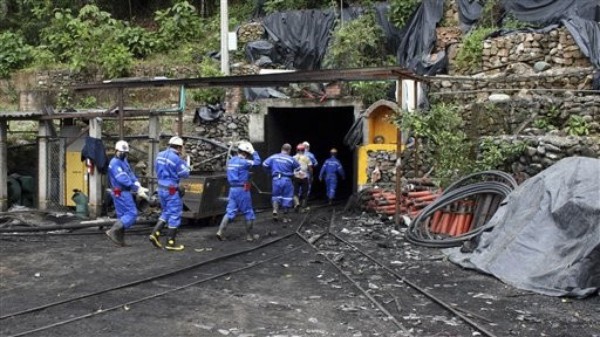Question: What's the single scariest page in any document that's rolled off the presses of the U.S. Government Printing Office in the last few weeks?
Hint: You won't find it in any of the 29 separate PDF files the OMB helpfully provides for citizens courageous enough to read the Obama administration's 2012 Budget.
Receive email alerts
Give up? It's page six of the U.S. Geological Survey's (USGS) Mineral Commodity Summaries 2011 report (PDF). There you'll find a chart titled: "2010 U.S. Net Import Reliance for Selected Nonfuel Mineral Materials."
To translate from USGS geek-speak, it's a table depicting U.S. dependence on foreign sources for key metals and minerals, excluding oil and gas. No other U.S. Government document, in a single page, maps the path of so many potential crises or conflicts.
The top half of the page tells an alarming story: From Arsenic to Yttrium, we see 18 "mineral materials" for which U.S. manufacturers - commercial and military - are 100 percent dependent on foreign sources of supply. In the case of 9 of those 18 minerals or metals, the U.S.'s No. 1 or 2 supplier is China. Next comes a baker's-dozen of metals and minerals for which the U.S. is 80 to 99 percent foreign-dependent, from the humble Antimony and Potash to exotics like Gallium, Germanium, Titanium and Rhenium. Some we buy from Canada, others from Kazakhstan. How sure we can be of our future supply is anyone's guess.
And that's the problem. It turns out, for all of our breezy pundi-fication about the U.S. being a post-industrial economy, we still build stuff out of things that have their origins in rock and dirt. The materials on the USGS list are found in the electronic gadgets we use for play and work, the weapons our military uses to keep us safe, and a range of green-tech applications we're counting on to free us from the tyranny of the carbon-based minerals that fuel our economy and foul our atmosphere.
That's where the fear-factor kicks in, because according to page six, we're more dependent on foreign sources for dozens of key resources than we've ever been dependent on OPEC for oil. We just haven't realized it yet.
So, what do we do?
We can start by reading the global signals that suggest we're heading into a period of resource scarcity.
Take the much-mentioned Rare Earths crunch. For a command economy, China is sending every signal it can right now that it doesn't intend to remain the world's near-monopoly Rare Earths exporter. That's good news and bad news. It's good, insofar as China may be chastened about repeating last October's unofficial Rare Earths embargo against Japan. It's bad news, insofar as the reason China may refrain from using its Rare Earths as a weapon is that its break-neck GDP growth will consume all of the Rare Earths it sweats out of the ground, and then some.
Rare Earths may be getting the headlines, but there's no reason to think things will prove much different for Fluorspar, Indium or Gallium. Shortages of any of those substances may not knock us out of our easy chairs, but translate them into the products they make possible: There go our flat panel TVs (Indium), our semiconductors (today), our fuel cells (tomorrow) - both Gallium - and our microscopes, telescopes and optical lenses (Fluorspar).
Glib comments that we can solve shortfalls by simply substituting for scarce raw materials in the manufacturing process deserve deeper examination. Substitution is not so easy. Take, for instance, Niobium (100 percent foreign-dependent, with Brazil our leading supplier), used in fabricating high-strength steel alloy. Instead of Niobium, you can substitute Vanadium as an alloying agent - and you'll only be switching U.S. dependency from Brazil to China (100 percent foreign-dependent, leading Vanadium supplier).
Or take Indium (100 percent dependent; China the No. 1 supplier), an essential ingredient in solar cells and semiconductors. Gallium Arsenide can substitute for Indium in solar cells and in some semiconductor applications. But we're 99 percent dependent on Gallium (China, No. 1 supplier) and 100 percent dependent for Arsenic (China again).
What we can do to work through a resource shortage differs, metal by metal and country by country. After all, there's nothing a nation can do if it drew the short straw in the sub-surface minerals lottery. But when a nation does have untapped resources, it needs a policy to address surety of supply. That means mining more if you're geologically blessed, keeping on friendly terms with like-minded governments that have resources you lack and diversifying away when possible from regimes likely to use their resource leverage against you in some future crisis or conflict.
For their part, Japan and South Korea have decided to co-partner with foreign countries and companies to develop scarce resources critical to their high-tech sectors, even as they begin to stockpile select metals - rainy-day resource funds whose cost will run into the billions.
As for U.S. policymakers, the looming resource crunch seems to be one more crisis that they're not ready to cope with right now. With trillion-dollar deficits and a debt-clock ticking down to doomsday, that's fair enough. But once Congress and the White House get the budget straightened out, it's fair to ask: What's our strategy for feeding our high-tech economy the metals and minerals it needs to grow? What's our national plan to cope with the coming Resource Deficit?
If you draw a blank stare, tell them to take a look into the future. They'll find it on page six of the USGS Report.
Daniel McGroarty, principal of Carmot Strategic Group, an issues management firm in Washington, D.C., served in senior positions in the White House and at the Department of Defense.
Read Full Article »




